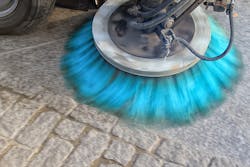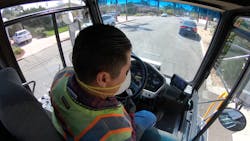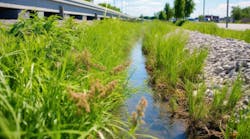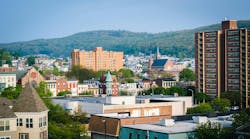In order to make the most of street sweeping programs, many communities pair their street sweeping efforts with a parking restriction schedule. In March and April, as states implemented stay-at-home orders and business either closed, reduced hours, or moved their employees to remote work, may communities modified their sweeping programs—either pausing sweeping entirely or, as is the case in San Diego, CA, pausing parking enforcement.
Stormwater spoke to Bethany Bezak, Assistant Deputy Director of Storm Water for the City of San Diego, recently about the city’s decision to pause parking enforcement while continuing to promote and protect the city’s water quality.
Stormwater: Could you tell us a little bit about San Diego’s street sweeping efforts?
Bethany Bezak: The city maintains 273 sweeping routes throughout the city, 75 of those routes are posted and they cover each one of our six main watershed areas of concern across the city of San Deigo. Last year we had just under 100,000 miles of street sweeping that we conducted across the city; street sweeping is included in all of our council districts, so it’s a pretty good representation of each one of those areas. It includes both residential and commercial areas, and our posted routes are also included in some commercial and residential areas.
When I say “posted,” I mean that there are parking restrictions and there’s a time when vehicles need to be moved from the streets to allow full access of the street sweepers into the curb and gutter lane. I’m sure you’re well familiar with street sweeping, but it is most effective when we’re able to get to that curb and gutter line because it allows us to get to the area where most of the debris and pollutants and trash are located.
SW: In California, there isn’t much rain around this time of year to carry sediment, trash, and pollutants into waterways. In San Diego, street sweeping itself wasn’t paused, but the parking restrictions were, correct?
BB: Street sweeping parking enforcement was paused back in March. We continued our full street sweeping operations, as far as running a street sweeper every single route as we typically would on our regularly scheduled days. However, we stopped the parking enforcement. So, for the routes that are posted for parking enforcement, we paused on that, which meant then that we would still send a street sweeper down that road but where vehicles were parked, they wouldn’t have access to the curb and gutter line.
It certainly added a layer of complexity, and our street sweeping is certainly not as efficient from a trash, debris, and pollutant removal (standpoint), but we still did continue our operations in that capacity.
SW: What kind of debris and pollutants does San Diego look to tackle with street sweeping?
BB: It does vary by the watershed and the area of concern. As I mentioned, we have six main watersheds in San Deigo and each one of those has different concerns as it relates to the pollutant of concern, from a water quality perspective. That can be anything from metals to nutrients or trash, but it also relates to whether or not an area is a heavily commercial area or a residential area.
SW: Were there any concerns around pausing enforcement, even while mitigating the impact by continuing sweeping?
BB: That’s why we wanted to continue our operations and have as much continuity as we possibly could. We’re best equipped to handle the pollution removal if we’re doing it on a consistent basis and while it’s not the rainy season, we felt that it was important to do as much as we possibly could. The regional board [San Diego Regional Water Quality Control Board] has also made it clear that the expectation is that we continue all of our water quality efforts; we’ve been deemed essential, and we should continue our operations as best as we possibly could.
SW: Why was it decided to pause? Has it resumed? What goes into that decision?
BB: It had initially been decided that we were going to reinitiate the full parking enforcement and street sweeping both starting on July 1st. That decision came out of the Mayor’s office, in terms of monitoring what the impacts of COVID were locally and how many people were getting back to work and so forth. As we were approaching that date, the mayor had decided to postpone the reinstatement of the parking enforcement to August 1st. Subsequently, we now have moved that to September 1st, so we have not actually restarted the parking enforcement; the plan right now is to restart that September 1st. The initial decision was made to help mitigate the impact of folks having to move their cars and in consideration that some people are still at home and there’s less activity in general.
SW: What kind of sweepers does San Diego use?
BB: We have what’s considered a regenerative air sweeper and we also have mechanical sweepers. Mechanical sweepers tend to perform best in areas with larger debris—the trash and larger materials that need to be removed from the road. Regenerative air sweepers—and we’ve done quite a few private studies to confirm pollutant removal—those types of sweepers tend to be much better with the fine particulate and also you know more pollution and nutrient base. We’ve done quite a bit of work in each one of the watersheds to make sure that we’ve selected the right sweeper for those locations to make sure that we’re achieving the greatest value out of the efforts.
We created some really great fliers that help educate people and remind them when the parking enforcement is going to be coming up. We’ve gotten good feedback that folks appreciate that there was a sensitivity to people being at home and more challenges with having available space to move their cars. It’s just going to be an ongoing effort to monitor how the pandemic is locally and what makes the most sense for us from an operations standpoint, but also from a community engagement standpoint.
SW: It sounds like the city is sensitive to the local state of the pandemic and modifying policies as the needs of the community dictate.
BB: We’re absolutely open to that, and I think it’s just going to be an ongoing evaluation and assessment about what makes the most sense. In some of the commercial areas, we have started to see that folks do want to get back out, and the mayor has been very open about trying to support local businesses. As a result, there has been an effort to make more outdoor signing available, and we’re just going to continue to monitor the situation and balance the operational needs and the community needs.
Another thing that would be helpful to note is that because we haven’t been utilizing our parking enforcement staff for their typical duties, we’ve been able to be creative and resourceful about how we spend that staff time. Very early on in the COVID situation, our parking enforcement officers were partnering with the police department as well as with the parks and recreation departments to help monitor closures of parks and give our police officers breaks when it was needed. That was a great example of cross-department coordination and everyone coming together to help the community.
From an operations standpoint, we’ve also taken the opportunity to assess all of our signage in the city to make sure that the signs are clear—that the posted stickers for the hours are clear and they’re visible. It has given us another opportunity to really do a full inspection and utilize our staff completely during this period. That’s one of the opportunities for a silver lining here: to revisit all those other activities.
We also supplied our parking enforcement officers and gave them training on over-irrigation and dry weather flows and have them doing neighborhood patrols to investigate those types of issues, too. That’s another area where I think there’s been an opportunity to benefit, from a water quality perspective.
SW: Have you noticed any water quality changes since suspending enforcement?
BB: The Storm Water Division consistently monitors water quality at strategic locations throughout our many watersheds throughout the year, but as of now, it is too early to assign any correlation or trends between the suspension of parking enforcement and water quality testing results.








